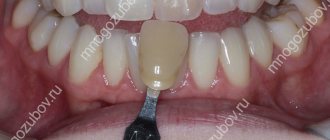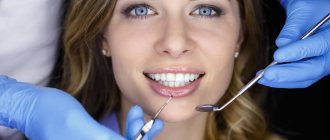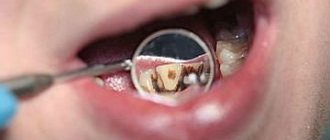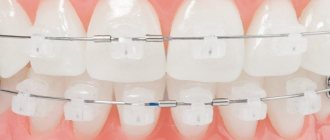Nowadays, it is difficult to imagine high-quality restoration and restoration of a tooth without an aesthetic component. Therefore, specialists in both therapeutic and orthopedic dentistry attach great importance to the selection of the shade of fillings, crowns, and veneers. After all, if the doctor makes a mistake, the teeth will look unnatural or stand out.
Modern fillings are made from composites - special polymer compounds that are applied layer by layer into the prepared cavity. If the color of the material is chosen incorrectly, the filling becomes noticeable to others.
Even more important is the correct selection of shade for the manufacture of veneers and crowns. Veneers are thin overlays that cover the vestibular (outer) surface of the front teeth. Patients often prefer bright white shades of veneers, a “Hollywood smile”, which is traditionally associated with success and high social status. However, this is not always justified, because it is the natural shade of the teeth that harmoniously combines with the tone of the skin, eyes and hair.
When installing a crown, it is important whether it is single or not. For example, if one missing tooth is replaced with prosthetics, the shade of the crown is matched to the color of the entire dentition. If the frontal group is being restored, the doctor can choose a shade for the entire group that is half a tone or tone lighter than the natural one, if the patient expresses such a desire.
What colors of teeth are there?
As a rule, the color of tooth enamel is milky white and translucent, but over the course of life, the tissue can become stained under the influence of various factors. The color of teeth depends not only, or rather not so much, on the enamel, but on the shade and quality of dentin, which shines through the enamel. The younger the person, the denser the layer of enamel on his teeth. In addition, the surface of the tooth is uneven, which means the light is reflected unevenly. The denser the layer of enamel is on the teeth and the more pronounced its surface microrelief, the less it shines through, and, therefore, the tooth looks whiter. Conversely, with age, the tooth surface smoothes out, the enamel layer decreases, and dentin begins to shine through more and more, the natural color of which is much darker than the enamel and can be light brown, yellow or gray. With age, the amount of enamel decreases, dentin also undergoes changes, and red-brown pulp begins to shine through the surface structures of the tooth, therefore, the teeth themselves acquire darker shades. It should be taken into account that dental tissues are usually colored unevenly over their surface: at the cutting edge the color is lighter than at the root. Different teeth also have different shades. For example, canines are often darker than incisors. Today, all age-related changes in the color of teeth are easily corrected by aesthetic dentistry, as well as any other problems associated with the appearance of the dentition.
Correctly selected color is a guarantee that the dentition will be aesthetically pleasing.
If the patient plans to regularly resort to whitening, the implant should be installed after the procedure so that its shade is not too dark. However, it will be impossible to neglect regular visits to the doctor and preventive professional cleaning , otherwise the artificial tooth will be a “light” spot in the mouth.
Proper oral hygiene helps maintain the light shade of enamel and its density. Use a quality toothpaste tailored to your needs, and not just rely on commercials that promise a “snow-white smile in just 14 days.” Don’t forget that the brush is no less important - it needs to be changed at least once every couple of months, stored strictly vertically with the head up, preferably in a case, and washed with warm water and soap before first use.
And, of course, you need to visit the dentist regularly. Professional teeth cleaning will help keep your teeth white , during which the doctor removes deposits from the surface of the enamel, stone and plaque. Compliance with the doctor’s recommendations plays a big role. So, after a whitening or cleansing session, you will need to give up coloring drinks and foods for some time - vegetable soups with tomatoes and beets, red wine, grape juice, and so on.
Natural tooth color
Speaking about the natural color of teeth, one cannot fail to mention the characteristics of people with different skin tones. For example, during a recent comparative study of representatives of the Slavic and Iranian groups, scientists identified such a feature. People of the Slavic and Iranian groups most often have a red-brown tint of teeth, less often - reddish-gray. At the same time, among the Slavs, teeth can also be reddish-yellow, but among Iranians, this color was not found in the color of the teeth, as well as gray - in both one and the other group. A comparative analysis of other nationalities shows similar results, indicating that the color of teeth is largely influenced by genetic characteristics and, to a lesser extent, by the environment in which a person lives.
Many people think that people with black skin have beautiful white teeth, but most often this is not the case. African Americans' smiles simply appear brighter. A similar effect, by the way, is observed in tanned people, even those who have only spent a little time in the sun. Therefore, when answering the question of what color natural teeth should be, one should rely on many factors, including those listed above.
By the way, the American Dental Association claims that teeth with a yellowish tint are easiest to whiten. In second place is the brownish tint of the enamel, and the worst response to the whitening procedure is gray teeth, which are often found among Americans.
Factors affecting shade
The tones of tooth enamel are individual, they are different for each person. The main factors influencing tone are:
- milk units are characterized by a perfectly white shade, since the enamel is still thin, it visually appears much lighter;
- a grayish tint is usually observed in teeth after depulpation, with fluorosis;
- the yellow tone is most common, it is associated with genetic factors, a thin layer of enamel through which dentin is visible, an increase in the yellow tint is characteristic of age-related changes, violations of hygiene rules, the darkest tone is observed in smokers;
- a brown tint appears with age-related changes; at a young age it is caused by food pigments, when taking drugs of the tetracycline group.
Before prosthetics, it is recommended to restore the natural tone. For this purpose, various bleaching methods are used, and office cleaning is carried out.
To clarify questions about dental restoration, please contact the specialists of the Denta-Labor clinic by calling (495) 162-08-25 . You can also make an appointment at a time convenient for you, for which you need to fill out an application on the website, spending just a couple of minutes.
How to choose teeth color
The practice of an orthopedic dentist involves the need to choose the shade of dentures. When making prosthetics or restoring one or more teeth in a row, the color is selected in accordance with the patient’s natural teeth. When making complete removable or fixed orthopedic structures, the patient has the opportunity to choose the desired color of the teeth. In this case, you should focus not only on your own desires, but also on the shade of your skin, hair and eye whites. Typically, teeth that are much lighter than the whites of the eyes look unnatural and stand out too much when you smile. In addition, the material from which the crowns or veneers are made should also be taken into account. Thus, plastic and composite materials used to restore teeth look different than metal-ceramics, even with the same color index.
Please note that the color of teeth will be perceived differently in different lighting conditions. That is why, when choosing the shade of veneers or dentures, it is necessary to follow a whole list of conditions, such as natural light, neutral color of the walls in the room and the clothes of the patient and the doctor, the absence of bright lipstick on the lips, and so on.
Where to get prosthetics?
Many clinics provide partial or complete prosthetics services. Find doctors based on reviews. Contact a clinic that has proven its professionalism through experience and work.
A doctor who knows his business will not rest until he brings his smile to perfection. The equipment of the clinic is important. Equipment in the hands of an experienced doctor works wonders. You will get what you expected.
As for the price, it depends on the case. Prices range from 1,700 rubles for simple crowns to 30,000 for lumineers or veneers. The procedure will cost 21,000 apiece.
Definitions of tooth color
When making dentures, technicians are guided by a special tooth color chart. According to the Vita scale, which is used by almost all dental clinics in the world, natural teeth can have only a few shades: brown, yellow, gray and red. Depending on the intensity category, colors are designated by numbers from 1 to 4. Thus, if a dentist talks about tooth color under the index A1, he means the lightest shade from the reddish-brown range of the table, accordingly, A2 will be slightly darker, A3 - even darker. Index B corresponds to the yellow tone of the teeth and varies in the same way according to the lightness of the shades (B1, B2, and so on). The gray shade is indicated by the Latin letter C (C1, C2, and so on), and reddish-gray teeth - D (namely Latin, not Russian D). The numerical index of the scale indicates the intensity of the color and starts from one, so tooth color 0 actually does not exist.
Professional scales and templates used in dentistry
Professional scales are usually produced by composites manufacturers. They are plates with samples of shades (teeth) made of ceramic, cardboard or plastic. Ceramic samples are considered the most accurate, since they are similar in properties to natural enamel, which means they refract and reflect light in a similar way.
One of the most frequently used is the Vita scale [2]. They are used to determine color in the manufacture of veneers, crowns, dentures, as well as when assessing the results of lightening in professional whitening. The shades in them are grouped into four groups:
● A – reddish-brown;
● B – reddish-yellowish;
● C – gray;
● D – reddish-gray.
In addition to the Vita scale, there are others, for example: GUMY, Chromascop, Vitapan 3D Master and so on [3]. There are also systems that are used exclusively in hardware methods.
Myth No. 5: if a filling suddenly falls out, you can insert another one in its place without treatment
It happens that a recently placed filling suddenly falls out at the most inopportune moment. And this is not always caused by toffees, chewing gum or other sticky products. Naturally, many people think that since the therapy was recent, there is no need to treat again. “The filling doesn’t just fall out. There's always a reason for this. And, as a rule, this is an inflammatory process (secondary caries). To avoid this in the future, it is necessary to eliminate it and only place a new filling in a “clean” cavity,” says Natalia Kadkalova.
Be careful, raid! How and why to clean your tongue? More details
Tone selection features
First, the dentist determines the group whose palette is close to the natural color of the element of the jaw row. Then select the desired color within one of the 4 shade ranges. It should not stand out against the background of neighboring dental units.
The Vita tooth color scale is a test ruler, which is characterized by the subjectivity of shade transfer. For artistic restoration, computer models are used to ensure extreme accuracy in color selection.
However, this technique does not always give the expected result.
Computer modeling is influenced by:
- lighting at the time of scanning;
- resolution of the equipment;
- camera color sensitivity indicator;
- correct setup and calibration of the program.
An error at one of the listed stages will lead to a distortion of the final result. The shade determined by the program will be lighter or darker than required, and will have an undesirable yellowish or bluish tint.
Vita tooth color scale
The use of such a technique significantly increases the cost of aesthetic correction procedures, therapeutic interventions or prosthetics. Most doctors prefer to trust their own vision and the classic Vita scale.
Myth No. 2: baby teeth can’t be treated
There is a strong opinion that due to the replacement of teeth, you can not pay attention to them at all. Dentists fundamentally disagree with this opinion. “Baby teeth are not only possible, but necessary to be treated. In childhood, inflammatory processes develop much faster than in adults. Secondly, the baby tooth must fully fulfill its function; it holds space for permanent teeth. If you lose it early, it will inevitably lead to bite problems in the future,” says Natalia Kadkalova.
What determines the natural shade of teeth?
Are your teeth not very white? Are they grayish or yellow in color? Let's see what the possible reasons for this are.
The gray tone is sometimes due to the presence of a large number of old fillings. If you have many teeth that had to be deprived of pulp due to its inflammation, be prepared for the fact that over time such teeth lose their natural shine and become gray. It is difficult to lighten them, but this can be achieved using a new method - endobleaching. In this case, the dentist drills out the old filling, frees the canal, fills it with whitening gel and leaves the gel there for 3-4 days. At the second session, he cleans the canal and puts in a fresh filling.
This is what you have to do with every tooth that is left without a nerve. The operation is long, painstaking, multi-stage and not cheap. But the result is worth a try.
Yellow teeth are common. This is the shade of enamel inherited by a person. Sometimes the enamel is very thin, and the color appears yellowish due to the fact that a layer of dentin, which has a yellow color, shows through the enamel.
Teeth turning yellow with age is normal.
As a person gets older, the pulp sometimes shows through the enamel, which becomes thinner. Then the tooth takes on a dark color, even slightly dark brown. A person may get scared and decide that a disease has begun, but in fact it is just a sign of age.
If your teeth are healthy, don’t let the yellowish tint bother you: dentists believe that such teeth are stronger than those that are white.
Teeth whitening and restoration techniques
If even careful care and regular professional hygiene do not allow you to completely get rid of yellowness, teeth whitening comes to the rescue. In our articles, we have already examined in detail the advantages and disadvantages of office and home whitening.
When darkening of the teeth is caused by severe thinning of the enamel, dental disease, or a general deterioration in the patient’s health, the first step is to correctly diagnose the problem and carry out appropriate treatment. Afterwards, it is possible to restore your smile with the help of veneers, lumineers and crowns.
We recommend that you try your best to keep your teeth healthy.
Conditions necessary for diagnosis
The result of a comparative analysis directly depends on external factors that distort the visual perception of color. Before the testing procedure, it is recommended to thoroughly brush your teeth and remove plaque from the oral cavity. The doctor performs additional sanitation with a special solution.
This treatment eliminates visually indistinguishable microscopic plaque, which changes the shade of the jaw rows. For a dental appointment, it is advisable to wear neutral or pastel-colored clothing with an open neckline so that the fabric does not obscure the surface of the teeth.
Testing is carried out only on completely healthy patients. In case of exacerbation of a chronic pathological process, respiratory diseases or inflammation, a visit to the dentist should be postponed until the physiological state normalizes. The office must have an appropriate level of natural light.
Advice from Dr. Zubastik
Don't like the color of your teeth? Don't worry, the problem can be solved. If you wish, you can buy a special set of mouth guards and lightening gel and lighten the enamel at home.
But first, consult your doctor: he may advise you to limit yourself to ultrasonic cleaning. In this case, the teeth will become half a tone whiter.
If it’s not enough, use a professional whitening service or install veneers. The main thing is that in pursuit of beauty, do not forget about dental health. Frequent bleaching weakens the enamel. Maybe it’s better to agree with what nature gave - after all, yellowish enamel is really a little stronger than ideal white?
Do you want to lighten your enamel? Watch how it happens:
Tags: Baby teeth, whitening, Teeth color, Vita scale
About the author: Dr. Zubastik
Typically, a toothache begins to subside on the way to the clinic and finally goes away after 10 minutes of sitting in line to see the dentist.
- Related Posts
- 10 foods that are good for your teeth
- Is it possible to remove tartar under compulsory medical insurance?
- We teach children to brush their teeth in the morning and evening on a schedule
« Previous entry










